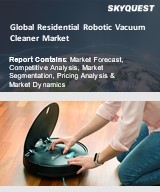
Report ID: SQMIG20N2031

Report ID:
SQMIG20N2031 |
Region:
Global |
Published Date: May, 2024
Pages:
204
|
Tables:
88 |
Figures:
72
Global Residential Robotic Vacuum Cleaner Market size was valued at USD 2.86 billion in 2022 and is poised to grow from USD 3.25 billion in 2023 to USD 8.95 billion by 2031, growing at a CAGR of 13.5% during the forecast period (2024-2031).
The global residential robotic vacuum cleaner market is influenced by a variety of drivers and restraints that shape its growth trajectory. One of the primary drivers is the increasing adoption of smart home technologies, driven by the growing trend towards home automation and convenience. Robotic vacuum cleaners offer homeowners the convenience of automated cleaning routines, allowing them to maintain clean floors with minimal effort. Additionally, advancements in robotic technology, such as improved sensors, navigation systems, and AI algorithms, have enhanced the performance and capabilities of robotic vacuum cleaners, making them more effective at navigating and cleaning various types of floor surfaces.
Moreover, rising urbanization and busy lifestyles have led to a greater demand for time-saving devices that can streamline household chores. Robotic vacuum cleaners cater to this need by providing a hands-free cleaning solution that frees up time for homeowners to focus on other tasks or leisure activities. Furthermore, increasing awareness of the importance of indoor air quality and hygiene has boosted the demand for robotic vacuum cleaners equipped with advanced filtration systems that can effectively remove dust, allergens, and pollutants from the air, contributing to a healthier home environment.
However, despite the numerous drivers propelling market growth, several restraints also affect the residential robotic vacuum cleaner market. One significant restraint is the relatively high cost associated with robotic vacuum cleaners compared to traditional vacuum cleaners. While the prices of robotic vacuum cleaners have decreased in recent years due to technological advancements and increased competition, they remain a premium product for many consumers, limiting their affordability and accessibility to a certain segment of the population.
Additionally, concerns about reliability, durability, and performance may deter some consumers from investing in robotic vacuum cleaners. Although technological improvements have enhanced the efficiency and effectiveness of robotic vacuum cleaners, there are still instances of malfunctions, navigation errors, and limitations in cleaning performance that may impact user satisfaction. Moreover, the complexity of robotic vacuum cleaners compared to traditional vacuum cleaners may pose challenges for some users in terms of setup, maintenance, and troubleshooting, potentially deterring adoption among certain consumer demographics.
Overall, while the residential robotic vacuum cleaner market continues to experience steady growth driven by technological advancements and changing consumer preferences, addressing these key restraints will be essential for unlocking its full potential and expanding market penetration in the future.
Our industry expert will work with you to provide you with customized data in a short amount of time.
REQUEST FREE CUSTOMIZATIONWant to customize this report? This report can be personalized according to your needs. Our analysts and industry experts will work directly with you to understand your requirements and provide you with customized data in a short amount of time. We offer $1000 worth of FREE customization at the time of purchase.

Report ID: SQMIG20N2031